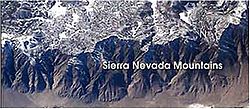- Delamination (geology)
-
In geophysics, delamination refers to the loss and sinking of the portion of the lowermost lithosphere from the tectonic plate to which it was attached.
This can occur when the lower portion of the lithosphere becomes more dense than the surrounding mantle. Because of the instability of higher density material atop lower density material, the lower lithosphere separates from the tectonic plate and sinks into the mantle.[1]
Delamination is of two basic types: brittle or ductile. In the brittle type, the lower crust metamorphoses to the denser eclogite, causing a density inversion,[2] which then may detach (rip away) and sink.
The second type, ductile delamination, is related to convective instabilities. The convection can simply peel away the lower crust. Or, in a different scenario, a Rayleigh-Taylor instability is created. Due to the instability in a local area, the base of the lithosphere breaks up into descending blobs fed by an enlarging region of thinning lithosphere. The space left by departing lithosphere is filled by an asthenosphere upwelling.[3]
Delamination of the lithosphere has two major geologic effects. First, because a large portion of dense material is removed, the remaining portion of the crust and lithosphere undergo rapid uplift to form mountain ranges. Second, flow of hot mantle material encounters the base of the thin lithosphere and often results in melting and a new phase of volcanism. Delamination may thus account for some volcanic regions that have been attributed to mantle plumes in the past.[4]
One example of the effects of lithosphere delamination is the Sierra Nevada mountains in the western USA.[5][6]
See also
- Lithospheric drip
References
- ^ Kay, RW; Mahlburg Kay, S. (1993). "Delamination and delamination magmatism". Tectonophysics 219 (1–3): 177–189. doi:10.1016/0040-1951(93)90295-U.
- ^ Hugh Richard Rollinson (2007). Early Earth systems: a geochemical approach. Wiley-Blackwell. p. 169. ISBN 1405122552. http://books.google.com/?id=9YRHu9kdPz8C&pg=PA169.
- ^ SB Nielsen et al. (2002). "Paleocene initiation of Cenozoic uplift in Norway". In Anthony G. Doré. Exhumation of the North Atlantic margin: timing, mechanisms and implications; Volume 196 of Special publications. Geological Society of America. p. 61. ISBN 1862391122. http://books.google.com/?id=Y9ttXxcWOiQC&pg=PA61.
- ^ Foulger, G.R. (2010). Plates vs. Plumes: A Geological Controversy. Wiley-Blackwell. ISBN 978-1-4051-6148-0. http://www.wiley.com/WileyCDA/WileyTitle/productCd-1405161485.html.
- ^ Manley, Curtis R.; Glazner, Allen F.; Farmer, G. Lang (2000). "Timing of volcanism in the Sierra Nevada of California: Evidence for Pliocene delamination of the batholithic root?". Geology 28 (9): 811. doi:10.1130/0091-7613(2000)28<811:TOVITS>2.0.CO;2.
- ^ Lee, C.-T.; Yin, Q; Rudnick, RL; Chesley, JT; Jacobsen, SB (2000). "Osmium Isotopic Evidence for Mesozoic Removal of Lithospheric Mantle Beneath the Sierra Nevada, California". Science 289 (5486): 1912–6. doi:10.1126/science.289.5486.1912. PMID 10988067. http://www.geol.umd.edu/~rudnick/Webpage/Lee_2000_Science.pdf.
See also
- Mountain building
- Orogeny
- Epeirogeny
- Plate tectonics
- Mantle convection
- Plating (geology)

This tectonics article is a stub. You can help Wikipedia by expanding it.

